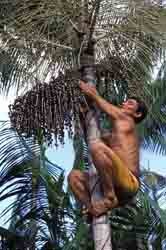
There is a small agriculture cooperative in the Brazilian Amazonthat has big dreams. Founded by Japanese immigrants in Tomé-Açu in 1931, the Cooperativa Agricola Mistade Tomé-Açu (CAMTA) produces pulp from tropical fruits, such as the açaí berry. With 117 members, the cooperative is one of the many small-producer clusters that, with help from USAID, has been developing export and trade links. Located near the coast of northern Brazil, Tomé-Açu is as close to São Paulo as it is to Miami. In fact, it is easier for farmers there to ship produce to the United States than to Brazil’s capital, Brasília. Road conditions and the risk of robbery on the way there sometimes make export markets more attractive to producers.
Nearly 99 percent of Brazilian businesses are considered small enterprises, and they employ over 50 percent of the workforce. Yet they account for a mere 3 percent of Brazil’s exports. USAID is working to increase small enterprise participation in trade by helping them develop and implement export plans, identify export markets, and seek strategic trade alliances with U.S. companies.
“CAMTA has done limited exports to Japan because of its origins, but we failed to access other export markets,” said Ivan Saiki, a 47-year-old Japanese Brazilian and the co-op’s commercial manager. With USAID help, the co-op ran an industry analysis to understand the sector’s challenges and opportunities. It then developed a long-term export strategy that considered market access as well as product and process improvements.
With USAID’s assistance, the cooperative has participated in several trade shows and trade missions in the U.S. “The hard work in identifying buyers, setting meetings, and preparing for both the fair and the trade mission paid off. We not only made some important business contacts but also had to manage a situation in which demand overwhelmed our production capacity of 1500 tons of açaí per season,” Saiki said. As CAMTA and other small producers gain trade experience, they will pave the way for more Brazilian entrepreneurs to participate in, and benefit from, the global economy.







Comment
Make a general inquiry or suggest an improvement.